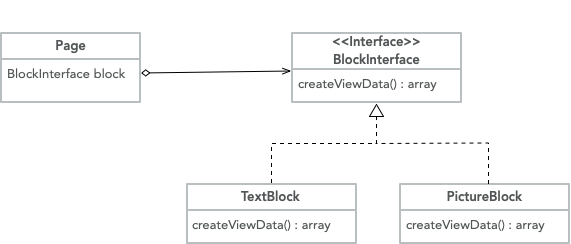Reference
Polymorphism
Imagine you have a model class that refers to an other class by just knowing it's interface and not the concrete implementation. Of course that's a very common use case in object orientated programming.
Here you can see a simple page class, that contains blocks like a text or a picture.

But if you want to translate this polymorphism into a relational database like mysql, it's not so clear how your table structure will look like.
Normally we are not interested how the sql schema will end up, because we use doctrine as our ORM layer which should take care of it. But in doctrine, we are not able to configure this out of the box. We need some help by extensions. Enhavo has it's own extension for that use case.
Implementations
In general, we have two obvious sql implementations with pros and cons. Let's have look at the page table.
+----+---------------+------------------+
| id | text_block_id | picture_block_id |
+----+---------------+------------------+
| 1 | 1 | NULL |
+----+---------------+------------------+
| 2 | NULL | 1 |
+----+---------------+------------------+With this structure we can use sql foreign key constraints, because one column is a reference to one specific table. This also gives us the option to use delete cascades. But if we add more and more blocks, the table is growing by adding a new column for each block we add.
Further, if we have a look to the php implementation, doctrine translates each column to a class property. As a result, to encapsulate the data model we need to use if or switch statements for each block.
class Page
{
private $textBlock;
private $pictureBlock;
public function setBlock(BlockInterface $block)
{
if($block instanceof TextBlock) {
$this->textBlock = $block;
} elseif($block instanceof PictureBlock) {
$this->pictureBlock = $block;
}
}
}This is an anti-pattern, because it violates the open close principle ("Open for extensions and close for modifications"). But we need to edit this file every time we want to add a block.
So let's have a look at the other possible implementation.
+----+--------------+----------+
| id | block_class | block_id |
+----+--------------+----------+
| 1 | TextBlock | 1 |
+----+--------------+----------+
| 2 | PictureBlock | 1 |
+----+--------------+----------+With this structure we don't need any further columns for blocks we add. We just need to inform someone that a TextBlock will resolve to an sql look up on the TextBlock table, which is a easy feature in doctrine.
On the other hand, we lose some sql features like foreign keys and thus delete constraints. This is a risk for inconsistent data. In some cases we can help ourselves by creating a reference from the inverse block tables back to the page table.
And how does our php code look like? Well, it's strait forward. We just implement the common polymorphism.
class Page
{
private $block;
private $blockClass;
private $blockId;
public function setBlock(BlockInterface $block)
{
$this->block = $block;
}
}Configuration
To make it work, the EnhavoDoctrineExtensionBundle will hooks into doctrine and takes care of resolving $blockClass and $blockId, and injects the correct block if you got the object from a repository.
For that you have to add some ORM mapping to your entity like in this example.
namespace App\Entity
use Doctrine\ORM\Mapping as ORM;
/**
* @ORM\Entity
*/
class Page
{
/** @var BlockInterface */
private $block;
/**
* @ORM\Column(type="string", length=255, nullable=true)
*/
private $blockClass;
/**
* @ORM\Column(type="integer", nullable=true)
*/
private $blockId;
public function setBlock(BlockInterface $block)
{
$this->block = $block;
}
}Now tell the EnhavoDoctrineExtensionBundle for which class you want to add the reference behavior and which field the listener has to observe.
enhavo_doctrine_extension:
metadata:
App/Entity/Page:
reference:
block:
idField: blockId
nameField: blockClassThat's all. The EnhavoDoctrineExtensionBundle takes care of App/Entity/Page